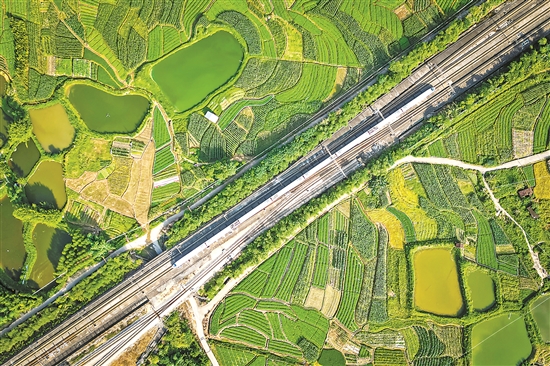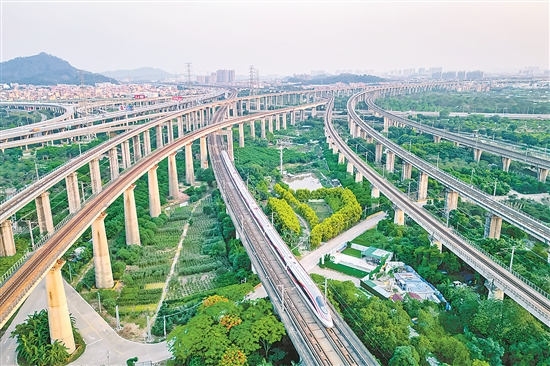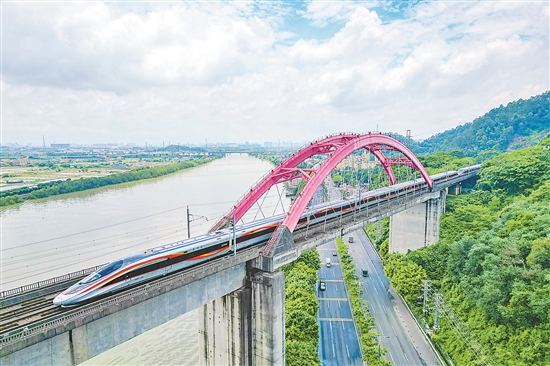
On June 15th, the Wuhan-Guangzhou High-Speed Railway (Wuhan-Guangzhou HSR) began operating under a new train schedule, enabling the Beijing-Guangzhou High-Speed Railway (Beijing-Guangzhou HSR) to run at a standard speed of 350 km/h along its entire length. This upgrade will significantly reduce travel time between northern and southern China.

Fifteen years ago, the Wuhan-Guangzhou HSR, which forms the southern section of the Beijing-Guangzhou HSR and was the world's longest high-speed railway at the time, officially opened. Since then, the route has been a focal point for the provinces and cities along its route. Starting from June 15th, the key north-south corridor will regularly operate at the high standard speed of 350 km/h, tightening the connections between the central regions and the Guangdong-Hong Kong-Macao Greater Bay Area. The enhanced speed promises more vibrant exchanges and economic interactions.

As one of the busiest passenger routes in the country, the Wuhan-Guangzhou HSR has transported approximately 1.685 billion passengers from its opening on December 26th, 2009, to May 31st, 2024. This number equates to each resident of Guangdong, Hunan, and Hubei provinces having traveled on the high-speed train more than six times.
At 9:50 AM on June 15th, train G814 departed from Guangzhou South Railway Station and arrived at Changsha South Railway Station 1 hour and 59 minutes later. "This is one of the fastest trips from Guangzhou to Changsha after the high-speed operation started," said Xiao Hongyu, the driver of G814.
The creation of a "two-hour economic and living circle" between Guangdong and Hunan and the acceleration of the central region's integration with the Greater Bay Area are significant achievements of the Wuhan-Guangzhou HSR over the past 15 years. This extensive land and sea connectivity, facilitating north-south interactions, is gradually unfolding across this vast region.
As China's first major long-distance high-speed railway, the Wuhan-Guangzhou HSR has served as a rapid, high-capacity "golden corridor" since its opening in 2009. It has quickly expanded the economic and living reach of the Pearl River Delta, the Changsha-Zhuzhou-Xiangtan city cluster, and the Wuhan metropolitan area. Cities along the high-speed rail lines in northern Guangdong, Hunan, and Hubei have continuously attracted investment, collectively hosting over 15,000 industrial transfer projects from the Pearl River Delta, with total investments exceeding one trillion yuan. High-speed rail new towns, high-speed rail new areas, and industrial parks have sprung up like mushrooms after rain, creating a massive industrial economic belt along the Wuhan-Guangzhou HSR corridor.

Since the opening of Guangzhou South Railway Station on the Wuhan-Guangzhou HSR, the station has handled a cumulative 1.48 billion passenger arrivals and departures, establishing its reputation as a "super hub." The movement of people has driven economic activity, turning the surrounding area into a dynamic new urban center. Covering approximately 310 square kilometers and spanning both Guangzhou and Foshan, this new city hub has evolved from a simple transportation node to a comprehensive service center for the Guangdong-Hong Kong-Macao Greater Bay Area, becoming one of Guangzhou's new landmarks.
Shaoguan, known as the "city connecting the north and south," has developed a unique high-speed rail new town centered around its HSR station. This new town, with a planned area of about 20 square kilometers and a population capacity of around 300,000, is set to become Shaoguan's future administrative, transportation, tourism, and financial center within the next few years.
In Hunan, the Wuhan-Guangzhou HSR has spurred the formation of a new urban area around Changsha South Railway Station, known as Wuguang New City. This area has rapidly developed high-quality commercial, financial, consulting, and exhibition services. Lituo Town, where Changsha South Railway Station is located, has grown from a small town of over 50,000 residents to an industrial hub with a population of 500,000. Changsha aims to develop this area into its version of Shanghai's Pudong. Recent GDP rankings of cities in Hunan show that five of the top six cities are located along the Wuhan-Guangzhou HSR line, highlighting the railway's significant economic impact.
Source :Yangcheng Evening News
武广高铁已发送旅客近17亿人次
6月15日,随着武广高铁实行新的列车运行图,京广高铁全线将按350公里时速高标运营,将进一步压缩我国南北地区时空距离。
15年前,武广高铁作为世界最长高铁——京广高铁南段正式开通运营。从此,车来车往,都被沿线省市注视。从6月15日起,这条南北大通道常态化按时速350公里高标运营,中部地区与粤港澳大湾区往来更加紧密。从此,岭南风更劲,潇湘景愈佳。
作为全国最繁忙的客运线路之一,武广高铁自2009年12月26日开通至2024年5月31日共发送旅客16.85亿人次,相当于粤湘鄂三省常住人口乘坐了6次以上高铁。
6月15日9时50分,G814次从广州南站始发,1小时59分后抵达长沙南站。“这是武广高铁高标运营后,广州至长沙的用时最短车次之一。”G814次司机肖宏宇介绍。
构建粤湘“两小时经济生活圈”,加速中部融“湾”,正是武广高铁15年打造的瞩目成果。一个陆海内外联动、南北双向互济的开放格局,正在这片广袤的大地徐徐展开。
作为我国首条长大干线高铁,武广高铁这一公交化、快速化、大能力的“黄金通道”自2009年开通运营以来,就迅速拓展了珠三角地区、长株潭城市群、武汉都市圈的经济生活半径。粤北和湘鄂高铁沿线城市持续引来投资热潮,共承接珠三角产业转移项目1.5万多个,总投资突破1万亿元。高铁新城、高铁新区、工业园区如雨后春笋不断耸立,武广高铁沿线“隆”起了一条巨大产业经济带。
武广高铁广州南站开通运营以来,累计到发旅客14.8亿人次,“超级枢纽”形象数尽风流。人的流动带动经济流动。以广州南站为中心的南站新城,规划面积约310平方公里,覆盖广州、佛山,从最初的广州市交通枢纽定位,已升级为粤港澳大湾区交通枢纽综合服务中心,成为广州新地标之一。
素有“南北咽喉”之称的韶关,以高铁站为核心崛起了一座粤北风情“高铁新城”,规划总面积约20平方公里,承载人口约30万人,在未来几年内基本成型,将成为韶关未来的行政、交通、旅游休闲和金融中心。
在湘楚大地,一个涵盖高品质商贸、金融、咨询和会展服务的武广新城已基本成形。目前,长沙南站所在的黎托镇由原来的5万多名原居民,发展到了50万产业大军。长沙市计划将其打造为属于自己的“浦东”。最近几年湖南省各城市GDP排名数据显示,全省前六位排名中,武广高铁湖南沿线5座城市全部在列。
文、图|羊城晚报记者 严锦程 通讯员 马鑫 董剑锋 曾勇
翻译 | 刘佳慧
-
Post-90s man in Zengcheng: Chef during the day and dragon head sculptor after work!
2024-06-19 23:04:55 -
Chinese electric vehicles surge in Thailand,BYD targets 150 stores in Thailand this year
2024-06-19 23:05:13 -
International students celebrate Chinese Language Carnival at GDUFS
2024-06-19 23:05:23 -
GBA leads China in number of super unicorn enterprises
2024-06-18 23:40:00






